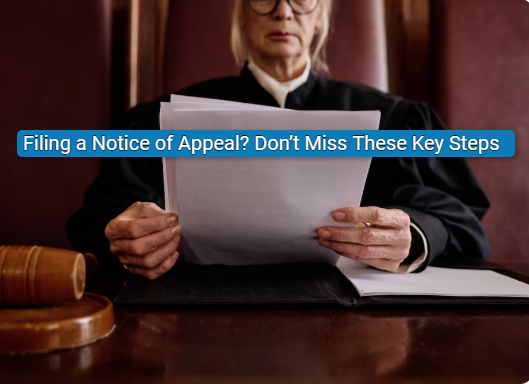Filing a Notice of Appeal? Don’t Miss These Key Steps

What to Include in Your Notice of Appeal
A clear, real-world guide from our lawyers at Passage Immigration Law
You know the feeling when you get the court’s decision, and it’s like hitting a wall? You’ve done the work, maybe even thought things went okay, and then—boom. Denied. Closed. Done. Except… maybe not.
That’s the moment we often meet our clients. When they’re still processing the decision, they know they can’t just let it go. Maybe the judge made a mistake. Maybe the law was misapplied. Or maybe, deep down, something just doesn’t sit right. That’s when we talk about the next step called the notice of appeal.
If you’ve never filed one before, it can sound intimidating. “What is a notice of appeal?” “How do I file a notice of appeal?” “Where do I send it?” These are the questions we answer every day at Passage Immigration Law, and this guide will help you understand exactly what to include in yours, without unnecessary legal jargon.
Let’s break it down.
What Is a Notice of Appeal (And Why It Matters So Much)?

A notice of appeal is your first official step in asking a higher court to review the decision made in your case. This is not your full argument. It’s not your day in court again. It’s a short legal filing that says, “I want to appeal this judgment.”
That’s it. But if you don’t file it—or don’t file it correctly—you lose the chance to appeal at all.
We’ve seen this happen to people who meant well. They drafted letters, called court clerks, and even filed detailed arguments, just not the official notice of appeal. And when they finally came to us, they were outside the deadline.
So if you’re wondering things like:
- “How long do you have to file an appeal?”
- “Can you file an appeal after 30 days?”
- “What happens if my notice of appeal was filed in the district, not the appellate court?”
Keep reading. We’re going to get into every detail—what to include, where to file it, and how to make sure you don’t lose your chance.
How Long Do You Have to File a Notice of Appeal?
Let’s get this out of the way now: in most cases, you only have 30 days from the date of the decision to file your notice to appeal. Some courts allow even less. And that clock starts the day the judgment is entered, not the day you receive a copy.
Once you pass that deadline, there’s no turning back. You cannot appeal.
We hear it all the time:
“Can I file an appeal after 30 days?”
Sadly, the answer is almost always no.
So if there’s even a small chance you might want to appeal, file the notice of appeal first. You can always decide later not to follow through with the full appeal. But you can’t go back and file a late notice.
Where Should You File the Notice?

This one trips up a lot of people. We’ve seen people accidentally file in the district court instead of the appellate court. Or vice versa. Immigration appeals? Those go to a completely different place depending on the type of case.
Bottom line: filing the notice in the wrong court—even if the paperwork is perfect—can get your appeal dismissed.
Each country has different rules, so always double-check where to file. If you’re not sure, we at Passage Immigration Law can confirm the correct court for you. We’ve done this hundreds of times.
What to Include in the Notice of Appeal (Step-by-Step)
Here’s what you need to include in the notice itself:
1. Your Case Information
- The full name of your case (e.g., “Jane Smith vs. USCIS”)
- Your role (appellant, petitioner, respondent)
- The original case number
- The name of the court and the judge who made the decision
2. The Judgment You’re Appealing
- Be specific. Include the date the order or judgment was entered.
- Mention the exact nature of the order (e.g., denial of I-485 adjustment).
3. The Court You’re Appealing To
- You must list the name of the appellate court (or agency) that will hear the appeal.
- Example: “U.S. Court of Appeals for the Ninth Circuit”
4. A Simple Statement of Intent
Here’s a line we often use:
“Notice is hereby given that [Name], the [role], hereby appeals to the [Court Name] from the final judgment entered on [Date] by the [Lower Court].”
Don’t get wordy. Don’t argue. Keep it clean and factual.
5. Signature and Contact Info
- You must sign it.
- Include your name, mailing address, email, and phone number.
Don’t Forget These Supporting Steps

Even if your appeal notice is technically correct, it can be rejected if you miss any of these details:
- Filing fee: Most appeals require a fee. If you can’t pay, ask for a fee waiver—but do it by the deadline.
- Proof of service: You must send a copy of the notice to the other party (e.g., the U.S. government, DHS counsel, etc.).
- Deadline tracking: Some courts require docketing statements shortly after you file. Don’t ignore any follow-up mail.
Common Mistakes to Avoid
We’re lawyers, but we’re human too—and we’ve seen good cases go bad just because of paperwork errors. Here are the biggest pitfalls:
1. Filing Too Late
Even a day late, and the court might say no.
2. Filing in the Wrong Court
This happens a lot when the notice of appeal is filed in the district, not the appellate court. Don’t rely on Google—confirm the right destination.
3. Writing an Argument in the Notice
Save that for the appeal brief. This isn’t the place.
4. Leaving Out the Date or Case Number
Courts need to know exactly what you’re appealing. No guesswork.
5. Skipping the Filing Fee or Proof of Service
Courts don’t chase you for missing documents—they just reject the filing.
What Happens After You File?
So let’s say you’ve filed it properly. Now what?
Here’s the usual timeline:
- The trial court prepares the case record.
- The appellate court sets a briefing schedule.
- You (or your attorney) prepare a full legal brief—this is where the real argument happens.
- The other side gets to respond.
- You might get a chance to reply again.
- Some cases have oral arguments, others don’t.
But none of this can happen if you don’t file your notice correctly and on time.
Should You File It Yourself?

Yes, technically, you can. But here’s what we’ve seen:
- People file in the wrong court
- Miss deadlines by misreading the rules
- Include way too much information in the notice
- Forget the service or fee
And once the time passes, no one can fix that—not even us.
That’s why we offer simple, fast consultations at Passage Immigration Law. If you’re not sure how to write or file your notice, we can walk you through it, or handle the whole thing for you.
A Final Word from Our Attorneys
Filing a notice of appeal isn’t about being loud—it’s about being accurate. Courts aren’t looking for emotion in this document. They’re looking for dates, names, and clarity.
At Passage Immigration Law, we help immigrants and families appeal difficult decisions every single day. Whether it’s an I-485 denial, a visa refusal, or an immigration court ruling, we’re here to help you. Book a consultation and take that first step the right way.
Because sometimes the system gets it wrong. And when it does, you deserve your shot to fight it.
Disclaimer: This article offers general legal information, not legal advice. Do not rely upon this information without seeking legal counsel. If you need legal advice, you may contact us directly to speak with an attorney. We disclaim all liability with respect to actions taken based on any information presented. Every case is different, and outcomes will vary depending on the unique facts and legal issues of your case.
